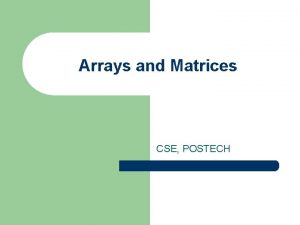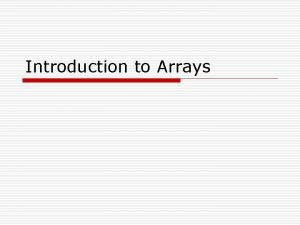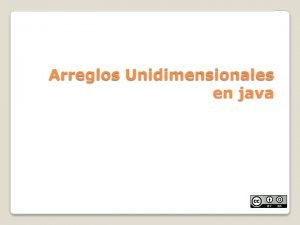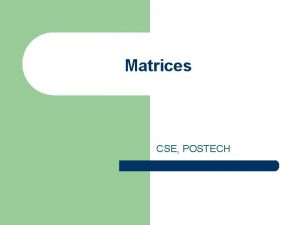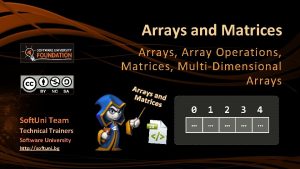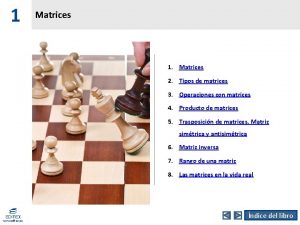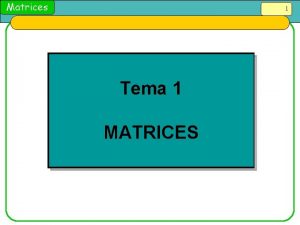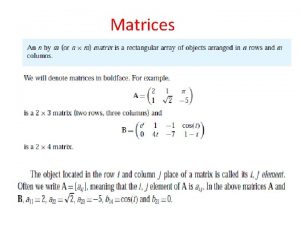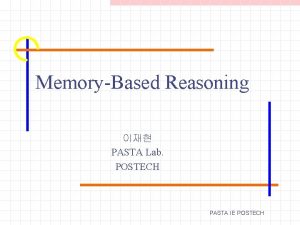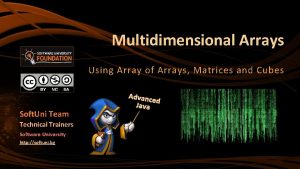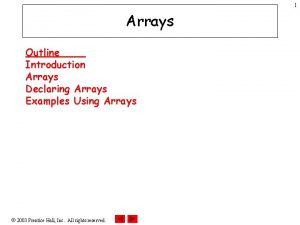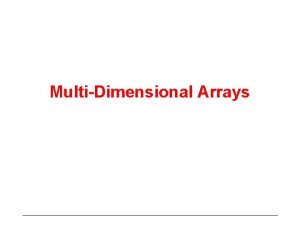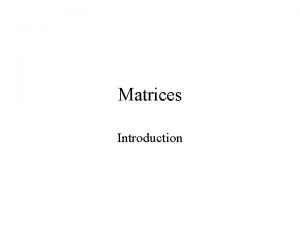Arrays and Matrices CSE POSTECH Introduction l l






![Rows of a 2 D Array a[0][0] a[1][0] a[2][0] a[0][1] a[1][1] a[2][1] a[0][2] a[1][2] Rows of a 2 D Array a[0][0] a[1][0] a[2][0] a[0][1] a[1][1] a[2][1] a[0][2] a[1][2]](https://slidetodoc.com/presentation_image/01d2498b47f962af3f35419b4efc6013/image-7.jpg)
![Columns of a 2 D Array a[0][0] a[1][0] a[2][0] a[0][1] a[1][1] a[2][1] a[0][2] a[1][2] Columns of a 2 D Array a[0][0] a[1][0] a[2][0] a[0][1] a[1][1] a[2][1] a[0][2] a[1][2]](https://slidetodoc.com/presentation_image/01d2498b47f962af3f35419b4efc6013/image-8.jpg)

![2 D Array Representation in C++ x[] l a b c d e f 2 D Array Representation in C++ x[] l a b c d e f](https://slidetodoc.com/presentation_image/01d2498b47f962af3f35419b4efc6013/image-10.jpg)
![Array Representation in C++ x[] l l l a b c d e f Array Representation in C++ x[] l l l a b c d e f](https://slidetodoc.com/presentation_image/01d2498b47f962af3f35419b4efc6013/image-11.jpg)

![Locating Element x[i][j] 0 c row 0 l l l 2 c row 1 Locating Element x[i][j] 0 c row 0 l l l 2 c row 1](https://slidetodoc.com/presentation_image/01d2498b47f962af3f35419b4efc6013/image-13.jpg)


![Row- and Column-Major Mappings 2 D Array int a[3][6]; a[0][0] a[0][1] a[0][2] a[1][0] a[1][1] Row- and Column-Major Mappings 2 D Array int a[3][6]; a[0][0] a[0][1] a[0][2] a[1][0] a[1][1]](https://slidetodoc.com/presentation_image/01d2498b47f962af3f35419b4efc6013/image-16.jpg)

![Irregular 2 D Arrays x[] 1 2 3 4 5 6 7 8 9 Irregular 2 D Arrays x[] 1 2 3 4 5 6 7 8 9](https://slidetodoc.com/presentation_image/01d2498b47f962af3f35419b4efc6013/image-18.jpg)






- Slides: 24

Arrays and Matrices CSE, POSTECH

Introduction l l l Data is often available in tabular form Tabular data is often represented in arrays Matrix is an example of tabular data and is often represented as a 2 -dimensional array – – 2 Matrices are normally indexed beginning at 1 rather than 0 Matrices also support operations such as add, multiply, and transpose, which are NOT supported by C++’s 2 D array

Introduction l l It is possible to reduce time and space using a customized representation of multidimensional arrays This chapter focuses on – – – 3 Row- and column-major mapping and representations of multidimensional arrays the class Matrix Special matrices ü Diagonal, tridiagonal, triangular, symmetric, sparse

1 D Array Representation in C++ Memory a b c d start l l l 1 -dimensional array x = [a, b, c, d] map into contiguous memory locations location(x[i]) = start + i

Space Overhead Memory a b c d start space overhead = 4 bytes for start (excludes space needed for the elements of x)

2 D Arrays The elements of a 2 -dimensional array a declared as: int a[3][4]; may be shown as a table a[0][0] a[0][1] a[0][2] a[0][3] a[1][0] a[1][1] a[1][2] a[1][3] a[2][0] a[2][1] a[2][2] a[2][3]
![Rows of a 2 D Array a00 a10 a20 a01 a11 a21 a02 a12 Rows of a 2 D Array a[0][0] a[1][0] a[2][0] a[0][1] a[1][1] a[2][1] a[0][2] a[1][2]](https://slidetodoc.com/presentation_image/01d2498b47f962af3f35419b4efc6013/image-7.jpg)
Rows of a 2 D Array a[0][0] a[1][0] a[2][0] a[0][1] a[1][1] a[2][1] a[0][2] a[1][2] a[2][2] a[0][3] a[1][3] a[2][3] row 0 row 1 row 2
![Columns of a 2 D Array a00 a10 a20 a01 a11 a21 a02 a12 Columns of a 2 D Array a[0][0] a[1][0] a[2][0] a[0][1] a[1][1] a[2][1] a[0][2] a[1][2]](https://slidetodoc.com/presentation_image/01d2498b47f962af3f35419b4efc6013/image-8.jpg)
Columns of a 2 D Array a[0][0] a[1][0] a[2][0] a[0][1] a[1][1] a[2][1] a[0][2] a[1][2] a[2][2] a[0][3] a[1][3] a[2][3] column 0 column 1 column 2 column 3

2 D Array Representation in C++ 2 -dimensional array x a, b, c, d e, f, g, h i, j, k, l view 2 D array as a 1 D array of rows x = [row 0, row 1, row 2] row 0 = [a, b, c, d] row 1 = [e, f, g, h] row 2 = [i, j, k, l] and store as 4 1 D arrays
![2 D Array Representation in C x l a b c d e f 2 D Array Representation in C++ x[] l a b c d e f](https://slidetodoc.com/presentation_image/01d2498b47f962af3f35419b4efc6013/image-10.jpg)
2 D Array Representation in C++ x[] l a b c d e f g h i j k l 4 separate 1 -dimensional arrays space overhead = overhead for 4 1 D arrays = 4 * 4 bytes = 16 bytes = (number of rows + 1) x 4 bytes
![Array Representation in C x l l l a b c d e f Array Representation in C++ x[] l l l a b c d e f](https://slidetodoc.com/presentation_image/01d2498b47f962af3f35419b4efc6013/image-11.jpg)
Array Representation in C++ x[] l l l a b c d e f g h i j k l This representation is called the array-of-arrays representation. Requires contiguous memory of size 3, 4, 4, and 4 for the 4 1 D arrays. 1 memory block of size number of rows and number of rows blocks of size number of columns

Row-Major Mapping l Example 3 x 4 array: l abcd efgh i jkl Convert into 1 D array y by collecting elements by rows. Within a row elements are collected from left to right. Rows are collected from top to bottom. We get y[] = {a, b, c, d, e, f, g, h, i, j, k, l} l l l row 0 row 1 row 2 … row i
![Locating Element xij 0 c row 0 l l l 2 c row 1 Locating Element x[i][j] 0 c row 0 l l l 2 c row 1](https://slidetodoc.com/presentation_image/01d2498b47f962af3f35419b4efc6013/image-13.jpg)
Locating Element x[i][j] 0 c row 0 l l l 2 c row 1 3 c row 2 ic … row i assume x has r rows and c columns each row has c elements i rows to the left of row i so ic elements to the left of x[i][0] x[i][j] is mapped to position ic + j of the 1 D array

Space Overhead row 0 row 1 row 2 … row i 4 bytes for start of 1 D array + 4 bytes for c (number of columns) = 8 bytes Note that we need contiguous memory of size rc.

Column-Major Mapping abcd efgh i jkl l l Convert into 1 D array y by collecting elements by columns. Within a column elements are collected from top to bottom. Columns are collected from left to right. We get y = {a, e, i, b, f, j, c, g, k, d, h, l}
![Row and ColumnMajor Mappings 2 D Array int a36 a00 a01 a02 a10 a11 Row- and Column-Major Mappings 2 D Array int a[3][6]; a[0][0] a[0][1] a[0][2] a[1][0] a[1][1]](https://slidetodoc.com/presentation_image/01d2498b47f962af3f35419b4efc6013/image-16.jpg)
Row- and Column-Major Mappings 2 D Array int a[3][6]; a[0][0] a[0][1] a[0][2] a[1][0] a[1][1] a[1][2] a[2][0] a[2][1] a[2][2] 16 a[0][3] a[1][3] a[2][3] a[0][4] a[1][4] a[2][4] a[0][5] a[1][5] a[2][5]

Row- and Column-Major Mappings l Row-major order mapping functions map(i 1, i 2) = i 1 u 2+i 2 for 2 D arrays map(i 1, i 2, i 3) = i 1 u 2 u 3+i 3 for 3 D arrays l What is the mapping function for Figure 7. 2(a)? map(i 1, i 2) = 6 i 1+i 2 map(2, 3) = ? l 17 Column-major order mapping functions // do this as an exercise
![Irregular 2 D Arrays x 1 2 3 4 5 6 7 8 9 Irregular 2 D Arrays x[] 1 2 3 4 5 6 7 8 9](https://slidetodoc.com/presentation_image/01d2498b47f962af3f35419b4efc6013/image-18.jpg)
Irregular 2 D Arrays x[] 1 2 3 4 5 6 7 8 9 l 0 Irregular 2 -D array: the length of rows is not required to be the same.

Creating and Using Irregular 2 D Arrays // declare a two-dimensional array variable // and allocate the desired number of rows int ** irregular. Array = new int*[number. Of. Rows]; // now allocate space for elements in each row for (int i = 0; i < number. Of. Rows; i++) irregular. Array[i] = new int [length[i]]; // use the array like any regular array irregular. Array[2][3] = 5; irregular. Array[4][6] = irregular. Array[2][3]+2; irregular. Array[1][1] += 3;

Matrices l l l m x n matrix is a table with m rows and n columns. M(i, j) denotes the element in row i and column j. Common matrix operations – – – 20 transpose addition multiplication

Matrix Operations l Transpose – l Addition – – 21 The result of transposing an m x n matrix is an n x m matrix with property: MT(j, i) = M(i, j), 1 <= i <= m, 1 <= j <= n The sum of matrices is only defined for matrices that have the same dimensions. The sum of two m x n matrices A and B is an m x n matrix with the property: C(i, j) = A(i, j) + B(i, j), 1 <= i <= m, 1 <= j <= n

Matrix Operations l Multiplication – – The product of matrices A and B is only defined when the number of columns in A is equal to the number of rows in B. Let A be m x n matrix and B be a n x q matrix. A*B will produce an m x q matrix with the following property: C(i, j) = Σ(k=1…n) A(i, k) * B(k, j) where 1 <= i <= m and 1 <= j <= q l 22 Read Example 7. 2

A Matrix Class l There are many possible implementations for matrices. // use a built-in 2 dimensional array T matrix[m][n] // use the Array 2 D class Array 2 D<T> matrix(m, n) 23 // or flatten the matrix into a one-dimensional array template<class T> class Matrix { private: int rows, columns; T *data; };

Shortcomings of using a 2 D Array for a Matrix l l Indexes are off by 1. C++ arrays do not support matrix operations such as add, transpose, multiply, and so on. – l l l 24 Suppose that x and y are 2 D arrays. Cannot do x + y, x –y, x * y, etc. in C++. We need to develop a class matrix for objectoriented support of all matrix operations. See Programs 7. 2 -7. 7 Read Sections 7. 1 -7. 2
 Postech cse
Postech cse Barnyard snort
Barnyard snort Postech cse
Postech cse Site:slidetodoc.com
Site:slidetodoc.com Cmse
Cmse Xiter10
Xiter10 Postech mse
Postech mse Mse postech
Mse postech Postech mse
Postech mse Postech mse
Postech mse Cmse
Cmse Postech mse
Postech mse Thermodynamics
Thermodynamics Hyeonseob
Hyeonseob Dynamic arrays and amortized analysis
Dynamic arrays and amortized analysis Searching and sorting arrays in c++
Searching and sorting arrays in c++ Array advantage and disadvantage
Array advantage and disadvantage Parallel arrays python
Parallel arrays python Array of arrays c++
Array of arrays c++ Parallel arrays
Parallel arrays Partially filled arrays
Partially filled arrays C++ parallel arrays
C++ parallel arrays Why do we need arrays?
Why do we need arrays? Vectores unidimensionales ejemplos
Vectores unidimensionales ejemplos Arreglos bidimensionales en java
Arreglos bidimensionales en java



